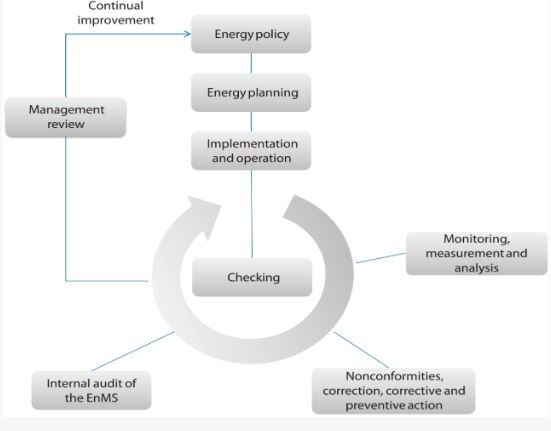Energy Efficiency is not a one-time job. Continuous energy management only can ensure an effective and energy-efficient operation of your production or service facility. Having a well-defined energy policy at corporate level, is the first significant step towards achieving long-term goals of energy management in the industry. A corporate level energy policy would give objectivity, purpose and motivation to all the efforts made throughout the organization in improving energy efficiency and managing best end-use of energy.
International Organization for Standardization (ISO) prepared the “ISO 50001 – Energy management system” by Project Committee ISO/PC 242, Energy management. The purpose of this International Standard is to enable organizations to establish the systems and processes necessary to improve energy performance, including energy efficiency, use and consumption. Implementation of this International Standard is intended to lead to reductions in greenhouse gas emissions and other related environmental impacts and energy cost through systematic management of energy. This International Standard is applicable to all types and sizes of organizations, irrespective of geographical, cultural or social conditions. Successful implementation depends on commitment from all levels and functions of the organization, and especially from top management.
This International Standard specifies energy management system (EnMS) requirements, upon which an organization can develop and implement an energy policy, and establish objectives, targets, and action plans which take into account legal requirements and information related to significant energy use. An EnMS enables an organization to achieve its policy commitments, take action as needed to improve its energy performance and demonstrate the conformity of the system to the requirements of this International Standard. This International Standard applies to the activities under the control of the organization, and application of this International Standard can be tailored to fit the specific requirements of the organization, including the complexity of the system, degree of documentation, and resources. (International Standard, Energy management system, 2011) ISO 50001 Energy management system is based on the Plan-DO-Check – Act PDCA) continual improvement framework and incorporates energy management into everyday organizational Practices.

SUJAL FOODS PVT. LTD (SPFL UNIT 2) is a leading manufacturer of confectionery products in Nepal and is one of the subsidiaries of the LAXMI GROUP, a reputed groups having diverse business segment all over the country. SPFL Unit 2 which is located at Pokhara Lekhnath, Bijayapur has undergone in development of Manual of energy management system ISO 50001:2011 in 2017 with support of FNCCI and GIZ.
The intent of ISO 50001 manual is adopted to establish the systems and processes necessary to improve energy performance, including energy efficiency, use and consumption. It is also intended to reduce environmental impacts from company operations and also to improve effectiveness of processes as energy is going to be the common parameters even to control process efficiencies which will lead to Energy Conservation and Improvement.
It covers all inputs pertaining to the establishment, implementation, maintenance and improvement of an Energy Management System at SFPL UNIT 2. This apex manual is prepared so that the overall EnMS is elaborated for implementation at all levels with an endeavor that all concerned including the Service Providers adopt a systematic approach in order to achieve continual improvement in Energy Performance, Energy Efficiency and Energy Conservation.
The manual addresses Energy Supply in all available forms, Energy Uses, Measurement, control, documentation and deviation analysis against all Performance Indicators and the Quantity of Energy use in various Processes, Activities, Services, Buildings, Equipment and Infrastructure under control of SFPL UNIT 2. The elaborated system also covers the Reporting of Energy Use, procurement and design practices for Energy Using equipment, systems and processes along with the details of performance criteria laid down for various segments of Energy use and consumption there on.
10 Key elements of ISO 50001 has been followed in preparation of Manual and reference during implementation of Energy management system in SFPL Unit 2 . Those elements are boardly defined as
- Energy policy top management’s official statement of the organization’s commitment to managing energy.
- Cross-divisional management team led by a representative who reports directly to management and is responsible for overseeing the implementation of the energy management system
- Energy review to assess current and planned energy use, energy sources and consumption and identify opportunities for improvement•
- Baseline(s) of the organization’s energy use
- Energy performance indicators (EnPIs) that are unique to the company and are tracked against the baseline to measure progress
- Energy objectives and targets for energy performance improvement at relevant functions, levels, processes or facilities within an organization.
- Action plans to meet those targets and objectives
- Operating controls and procedures for significant energy uses
- Measurement, management, and documentation for continuous improvement for energy efficiency
- Internal audit of progress reported to management based on these measurements.
SPFL Unit 2 has been continuously implementing the guided manual of EnMS ISO 50001 and planning to get certification on ISO 50001 in future. Similarly, as a lesson learned, Sujal food is also projecting to develop such EnMS manuals for its other subsidiaries



